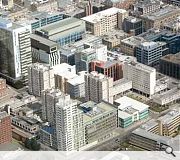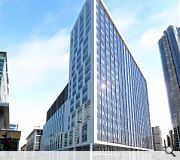Aedas detail Bothwell Plaza vision
September 10 2008
Prospect set sail with Aedas through stormy economic waters for the launch of the practices landmark £100 million Bothwell Plaza scheme. But will the architects sail rings around the competition? Or end up all at sea?Initially penned by SMC Jenkins and Marr the originally submitted scheme hit an impasse with planning officials, critical of over scaled service bays, lop sided public realm and a lack of active frontages.
Stuart Graham, Aedas project architect reveals: “A lot of the townscape analysis was criticised by the urban design panel and various other bodies in the consultation process. There was quite a lengthy dialogue with the planners who were not supportive of the scheme as it stood and as a means to breaking that impasse, European Development Company approached us (in February) because of our involvement with the Anderston area, to bring a wider vision to the area and join up what’s happening down here. “
The planning department subsequently stipulated to Aedas that any successful submission would require as a pre-requisite to have Waterloo and Bothwell Street’s treated equally. In addition the full ground floor should be enlivened with active frontages and diminished service access. Inclusion of the Holiday Inn Express “looked like over development” and was removed.
“What we’ve tried to do is go right back to first principals, basically ignore the previously submitted scheme.” Stuart continues: “You’ve got a strong dense historic core and then a different sort of urbanism down to the motorway beyond that. The site is in a transitional zone, the motorway forming a boundary. You’re starting to look at a tall buildings zone, with the planners looking at where tall buildings might be permitted and encouraged. You have this cluster running up the side of the motorway with things like the Cheapside development, the Broomielaw and Elphinstone which is certainly approved as a tall building, if unlikely to go ahead in quite that form.”
Stuart adds: “You have to look at the wider context as well with the Commonwealth Games, this is a big issue for the council as is the general shortage of circa 3,000 beds. Losing the Albany has obviously impacted on that, five star beds are what the city’s crying out for. There is a big opening in the market, it’s really under provided for and the client sees this as part of that. They want this to be the best hotel in the city centre.“
The result of this intensive dialogue is a singular building comprising three wings wrapping around a south facing courtyard atrium space, orientated to maximise natural light and views. Clad in anodised aluminium, black granite effect plinth, polished white carea rainscreen cladding, a taller 19 storey curtain wall element is oriented to the western gable, the tallest commercial premises in the city, this minimises the effect of a prevailing south westerly wind. Weather combined with limited size of the city block and commercial imperatives counted against an external square.
An element of height was considered desireable from an early stage. Glasgow’s relatively low level and compact city centre is ringed by clusters of much taller social housing towers. From long distance views and from the air the city centre is difficult to locate, the reverse of North American cities. There are approx 150, 20 storey towers within the city, only 15 in the city centre. Stuart attributes this to a loss of confidence in the 60’s and 70’s. Right through the 80’s it was difficult to do things not in historical styles.
Stuart says: “Glasgow has traditionally put tall buildings on the periphery, in suburban areas. There are a whole number of reasons for that, land values and things like that. But brownfield sites are getting used up, people are starting to go higher in the city centre. Our client wants a bit of confidence. Our aspiration is not a million miles from the College of Building and Printing, but dealing with each side of the building in a different manner. It’s responsive architecture.
But how receptive will the authorities be to such ambition? With over a 100 objections received from the Pinnacle despite no legal right to a view and extensive sunpath analysis, might the authorities back down? Stuart comments: “Planners have been historically supportive of gateway features in that location. They wanted the Eagle building to go higher. We’ve been looking at something that fits in with that cluster of tall buildings and forms a significant gateway feature. We want to respond to the immediate context of Bothwell and Waterloo St and the wider context of long views. In general planners are fairly responsive to that but there has been an ongoing dialogue over key views and some of our responses to that, there’s a kind of compromise. We’ve looked at 24 and 25 floor options, floated 35 floors at one point, but once you start to go beyond 20 stories you start to get into completely different lift solutions and lifts are a real killer in commercial buildings. The lift consultant initially came back and quoted 10 lifts which take up half the floorspace, you get to a point of diminishing returns. You have such a high population in the building so you need 10 lifts but then you have 10 lifts so you can’t have such a high population. It’s slightly different when you put the hotel part of the tower because you don’t have such high volumes of traffic and waiting times.”
Explaining the physical make up of the complex, Stuart describes: “Office space has been placed in the tower to give more height with the different floor to floor ceiling heights. The hotel sits on the eastern part with an entrance off Douglas St, a real grand entrance for a five star hotel. Then you’ve got the atrium space in the middle from there you’ve got access into the bars, function space and offices from there. So you can come down and have a coffee, use the café and the bars so we see this as quite a lively space and quite a unique one, certainly for Glasgow It’s that principle of a genuinely mixed use development, its something that is knitted together as much as possible and functioning together. The Exhibition space that the hotel uses, they’re talking about launching new cars there with one of the best restaurants in the city. They’ve got real ambitions for this and then you’ve got the function suite of the hotel looking down into it and then up on top of that you’ve would have a landscaped roof terrace.”
Despite this noble aim however Aedas Director Richard Blair advised Prospect that planners remain uneasy about offices in a tower format, stating that the commercial case needs to be proven. Concern has been voiced that bringing such a volume of office space to market here may compromise competing developments along the Broomielaw.
Stuart continues: “We’re looking to create this big, bold statement. Glasgow is a city of big and bold architectural statements, it’s about being pretty straight forward and simple about how you do it, there’s some pretty broad brush strokes, applying some detail to give it a bit of richness. The big glass feature wall faces toward the west but imposing upon that is a big steel latticework that adds a bit of texture and pattern. We’re still developing the cores at the moment but there is a strong possibility that you’d be able to see the lifts running up and down behind the glass. We have a couple of images that we are developing that will show how these lift lobbies will look, a couple of glass walls and then uninterrupted views out to the motorway and the west. Unique outside of London at that sort of height. So the office space is going to be pretty spectacular and unique, certainly in Scotland.”
This dynamism is set to be reflected within a system of LED lights behind ETFE bubbles similar to the Allianz Arena, Munich. Down on the ground different treatments have been adopted for each frontage to recreate a richness of the city block. Bold, abstract elements express corner conditions while elevations are treated with a play of horizontals and verticals. Modular off site construction will be employed for the construction of all hotel rooms.
A key consideration has been linking with the final phase of the Anderston centre masterplan. This would remove the remainder of the existing megastructure and overhead walkways to re-establish pedestrian through routes.
Speaking on the neighbouring Anderston area Stuart says: “We’re also looking at a wider vision for the masterplan area for how it might expand into the Marriott site. It’s very early days, it’s all up for grabs at the moment, nothing’s finalised. We just want to set the context here where you can start to look at a wider part of the city. We can address the motorway on ramp there so you can start to look at this as a series of objects or events across that route, this is all speculative stuff but you could have that whole corridor as a sequence of events, a cluster of towers.
|
|
Read next: Animal antics
Read previous: Michael Laird isn't spared job losses
Back to September 2008
Like us on Facebook
Become a fan and share
News Archive
Search News
Features & Reports
For more information from the industry visit our Features & Reports section.





